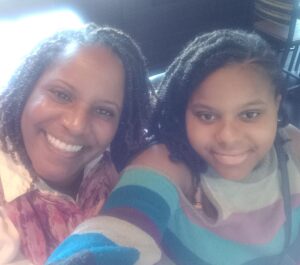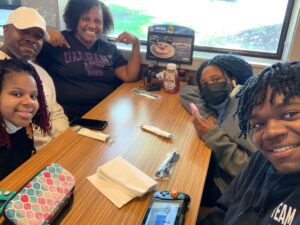
Rare Community Profiles is a Patient Worthy article series of long-form interviews featuring various stakeholders in the rare disease community, such as patients, their families, advocates, scientists, and more.
The Resilient Parent: How Her Daughter’s MCTD Led Ronda to Help Families Navigate Rare Disease Diagnoses
It all began with a bruise.
Or, as Ronda Thorington began to count the purple whorls that decorated her daughter Raeah’s legs and back, many bruises.
At four and a half years old, it’s normal for a child to have the occasional bruise—a fall here, a collision there– all part of the rough and tumble of childhood.
But her daughter couldn’t remember falling and didn’t feel sore, so what was happening seemed to come out of nowhere.
For Ronda, a seasoned Licensed Professional Counselor with over two decades of experience specializing in helping children and families, these bruises marked the beginning of a journey she never could have anticipated: a journey to Raeah’s eventual rare disease diagnosis.
Yet amidst the challenges of this diagnosis, Ronda found faith, resilience, and purpose. Her clinical acumen became her guiding light through the tempest of change. But she identified a significant gap: mental health support for families facing rare diseases was sorely lacking.
In 2021, Ronda set out to fill this gap and pass along tools and lessons to others navigating their child’s rare or chronic illness diagnosis; she later formalized her work as Resilient Parent Consulting. Through her unique blend of personal experience and professional expertise, she has become a vital resource for the rare disease community.
Ronda recently spoke with Patient Worthy to underscore the importance of helping families recognize the possibilities of the future and release self- and societally-imposed limitations on what living rare means.

The Fight for Answers
At the pediatrician, tests showed that Raeah’s platelets were dangerously low, sitting at 10,000 mcL. The normal mcL, according to Mount Sinai, is between 150,000 and 400,000. Because of this, the family was sent to the local children’s hospital. Their philosophy? Observation.
Eventually, doctors diagnosed Raeah with immune thrombocytopenic purpura (ITP), saying that it was most likely caused by a viral infection. Each week, Ronda took her daughter back to the hospital to monitor her condition through blood draws. It was torture, she says, because they’d have to hold Raeah down to draw blood. Still, her platelets started rising—seemingly positive news.
However, Raeah soon developed a smattering of seemingly random symptoms that Ronda struggled to wrap her head around. First came the joint pain and swelling that was sometimes severe. Says Ronda:
“Her gait changed and became awkward. The side of her face would swell up to the point where she couldn’t move her head. When I took her to the hospital, they told me that it was just another virus. That didn’t make any sense to me.”
Medical providers in her family connected Ronda to Boston Children’s Hospital, where she pursued additional testing for her daughter. Still no answers—bloodwork ruled out autoimmune issues and cancer, and the platelets returned normal.
Months later, Ronda’s father came to watch the kids while Ronda went to work. One morning, he pointed out Raeah’s stiff movements as she came down the stairs, telling Ronda:
“I move like that as a 72-year-old man.”
Cue more pediatrician visits, more testing. This time, however, doctors discovered severe joint inflammation and antinuclear antibody (ANA) levels that were off the charts. After another visit to Boston Children’s Hospital and multiple rounds of testing, the family was exiting the hospital’s parking garage when they received a phone call. Labs had been run and, according to doctors:
“There was no diagnosis yet, but Raeah had very bad systemic inflammation that needed to be fixed. They told us that she had to start high-dose steroids ASAP, that the steroids had already been called into the pharmacy, and that we were to stop there on the way home to pick them up.”
Within two weeks, though, the family finally received an answer: Raeah had mixed connective tissue disease (MCTD). The words that the doctor told Ronda still echo in her mind 13 years later:
“You’re going to see a lot of specialists over the next 10 years. This is going to be life-threatening if not controlled, so we need to treat it aggressively.”

What is Mixed Connective Tissue Disease (MCTD)?
Mixed connective tissue disease is a rare systemic inflammatory rheumatic disease that shares symptoms with multiple other disorders, such as lupus and polymyositis. Some doctors refer to MCTD as an overlap disease as symptoms usually appear in a sequence over a set number of years. Doctors don’t know exactly what causes MCTD. Right now, it’s believed that the immune system mistakenly attacks healthy cells, leading to symptoms.
MCTD can occur in people of all ages. However, the National Organization for Rare Disorders (NORD) suggests that mixed connective tissue disease has an average age of onset around 37 years old. This information is similar to what Ronda found during her research, explaining:
“No information seemed to fit. Everything I found told me that mixed connective tissue disease typically impacts middle-aged Caucasian women and my daughter was a young Black girl. The doctor told me he had never seen MCTD in such a young child. She is literally one in a million.”
Symptoms and indications of MCTD may include:
- General malaise
- Swollen fingers or hands
- Muscle and joint pain and inflammation
- A rash (red/brown patches) that often appears on the knuckles
- Cold and/or numb fingers or toes OR blue/white color changes (Raynaud’s phenomenon)
- Thickened skin on the fingers or face
- Hair loss
- Gastroesophageal reflux
- Difficulty swallowing
- Pulmonary hypertension or interstitial lung disease
Right now, there is no cure for MCTD. Symptoms can be managed using a variety of medications including corticosteroids, antimalarials, immunosuppressants, and calcium channel blockers. Getting her daughter’s condition under control was challenging for Ronda. She shares:
“Our doctor expected her to have a very difficult course of MCTD and he wasn’t wrong. She took numerous medications from oral to infusion. They would work—then suddenly stop. What finally worked was a medication that depletes her B-cells. This class of medication was just being developed when she was at her sickest, so at 11 years old, she was actually the youngest person in the world to receive this medication. They developed a protocol specifically for her. Luckily, this is the one that has helped stabilize her.”
The Mental Health Burden of a Rare Diagnosis
Rare disease diagnoses place a substantial burden on the mental health of both patients and their families. Beyond the physical symptoms and medical complexities, individuals confronted with rare diseases often experience profound emotional challenges. The journey from diagnosis to treatment involves navigating a landscape fraught with uncertainty, fear, and grief. Shock and disbelief frequently accompany the initial revelation, giving way to a complex array of anxiety, depression, and sadness. Says Ronda:
“I definitely went through the stages of grief. It was even more complicated because someone close to me was also diagnosed with leukemia. I lean on my faith a lot and that was a time in my life I felt forsaken by God. I didn’t understand why this was happening. Sometimes others, in an attempt to empathize, would compare a very benign medical issue—‘oh, my child had the flu and I had to miss work’—to what my daughter was going through when she couldn’t even go to school. My frustration and anger took over, and I withdrew from the people around me.”
Ronda scaled back her psychotherapy practice to stay home and care for her daughter, who was also dealing with feelings of isolation and alienation as she transitioned from a happy-go-lucky kindergartner to being sick all the time. As she missed school for several months, her friend group slowly disappeared. Even when Raeah returned to school, she struggled with questions about her health or her appearance. Ronda explains:
“High-dose steroids drastically changed her physical appearance, so her peers would ask about the physical changes. In first grade, I went to speak with her class because children would ask her if she was going to die, which was very overwhelming for her. She became incredibly isolated, angry, and depressed.”
Managing Household Changes
Ronda didn’t know what to do, but she did know that she had to do something to help her daughter. So she dug into her “professional counselor bag of tricks,” to access her clinical skills like psychosocial emotional health and wellbeing to navigate the uncertain waters ahead.
One thing that she implemented in her household was maintaining a sense of normalcy. Ronda shares:
“She loves music, so I found a piano teacher who could give her private lessons during the school day. Her dance teacher let her come in for private lessons whenever she was able, or group lessons whenever she felt up to it. Raeah never missed a recital and felt more connected to that group. Our church community was a strong base of support, so she would attend Sunday school to have time with other kids. She’d also spend time with her younger sister and older brother. They’d come home from school, tell her about their day, and do narrative play like telling stories—one person would start the story, the next would continue, then the next. It was really beautiful.”

Ronda and her husband were also very intentional in making sure that their other two children received familial support and were not, as Ronda describes, ‘lost in the shuffle.’ She says:
“Raeah required so much time, attention, and resources that we wanted to make sure our children still got what they needed through 1:1 time. We checked in and asked, ‘Are you getting enough from us?’ Before bed, I would fill their minds with good things. We also opened the conversation and created space for them individually to share their concerns or ask questions. I remember asking my son if he had anything he wanted to know about what’s going on. Most nights, he would say he was fine. Then one night, he asked if Raeah was going to die because people go to the hospital to die and she goes there a lot. If I hadn’t asked him, I don’t know if he ever would have shared that worry, or we would have ever gotten to talk about it.”
To Ronda, these intentionalities and actions have served to strengthen her connection with her family and to strengthen their connection with each other. After seeing the benefits that her family gained from blending her clinical and personal expertise, healthcare providers began telling Ronda that she should formalize her work and offer it to other families. When the coronavirus pandemic hit, she knew it was the right time.
Coping Strategies for Caregivers in Rare Disease
While you can reach out to Ronda for more in-depth coaching, she did offer some helpful coping strategies and tips for caregivers of rare disease that she was willing to share with Patient Worthy.
Self-Care
First, says Ronda, it’s important to engage in self-care. We cannot adequately take care of others if we’re not also taking care of ourselves. Of course, rare disease caregivers face a variety of challenges from the financial burden of treatment to frequent travel or feelings of distress. So self-care is even more vital. Ronda shares:
“Make sure that you have a good exercise routine. Don’t be afraid to speak to a mental health professional or coach if you need support. Take time for yourself to take care of your physical needs. For me, one thing I had to do was scheduling my well-visits. I spent so much time pushing my health to the side—then suddenly it’s been years since I’ve gotten a checkup.”
Be an Advocate
When you go into meetings with healthcare providers, you’re meeting with people who are experts in their fields or have done doctoral level research. Sometimes, that makes it hard to ask questions or speak up when you feel like something isn’t right. But, reminds Ronda:
“You are the expert in all things pertaining to your child. You can tell when they’re sad, disappointed, or not feeling well. You can listen to the sound of their voice and tell if they’re having an asthma attack or not. That is something that medical providers don’t have. You are an expert in your own right. So don’t get intimidated.”
When it comes to advocating for your child, Ronda stresses that you should:
- Ask from a place of curiosity rather than combativeness. She says that asking, “Can you explain why this medication might work better than the other?” often confers a greater sense of collaboration rather than, “Why do you want my kid on this medication?”
- Not be afraid to ask for a second opinion. Follow your gut. Don’t ignore that instinct. If you feel like something is “off,” it’s okay to see someone else. It’s okay to fire your provider. Ronda did when the relationship no longer felt healthy. And working with your medical provider is a relationship—if you feel dismissed, not heard, or like there isn’t room for your opinion, it isn’t healthy and it’s time to move on.
Live in Gratitude
Understandably, gratitude can sometimes be hard to come by on a rare disease journey. But, says Ronda, finding that gratitude—and finding humor in the absurdity of the situation—can be immeasurably helpful:
“From a psychological perspective, we know that living in a space of gratitude can change us biochemically. It can make us less anxious, less depressed. Picking out something every day that I can be grateful for sustains me. There’s a misconception that gratitude has to be big, but that isn’t true. Gratitude can be being thankful for a good cup of coffee, that there was a sunrise, that you didn’t get stuck in crazy traffic. It shifts you from a space of lack to a space of abundance.” Also, gratitude doesn’t make you a ‘PolyAnna’, ignoring all of the bad stuff. It just allows you to create an equal amount of space for the good in your life.
As you’re practicing gratitude, also learn to take yourself—and life!—less seriously. Ronda explains that parents, especially in the rare disease community, carry guilt. By recognizing and rolling with the blows, she’s found ways to let go of that:
“Sometimes things happen. Sometimes insurance doesn’t cover medicine, or—like my daughter—your child is allergic to the only medicine that works, so an hour-long treatment now takes three days to mitigate the risks. You just have to laugh. Give yourself grace. Don’t push yourself past your energy. Our genes may have caused our kids’ rare disease. But our genes also made our kids beautiful, successful, and smart in their own right.”
At the end of the day, Ronda feels grateful not just for her family and what they’ve brought to her, but for her ability to bring insights to other parents through sharing psychoeducational and social emotional tools. She says:
“Nothing breaks my heart more than having parents come to me and just seeing the defeat, sadness, and loneliness they’re feeling. To give them these strategies, these tools…to create the shift and give them lightness and hope, there’s nothing that fills my cup more.”
Ronda launched Resilient Parent Consulting to help bring clarity to families as they navigate their journey. Her work encourages caregiver self-care, helps families understand how to find and feel comfortable in a new normal, and how to release and identify limiting beliefs that prevent them from having the family life they deserve.
If you are interested in speaking with Ronda, you may visit her website above. You can also find her on Facebook, on Instagram, on LinkedIn, or at [email protected].








